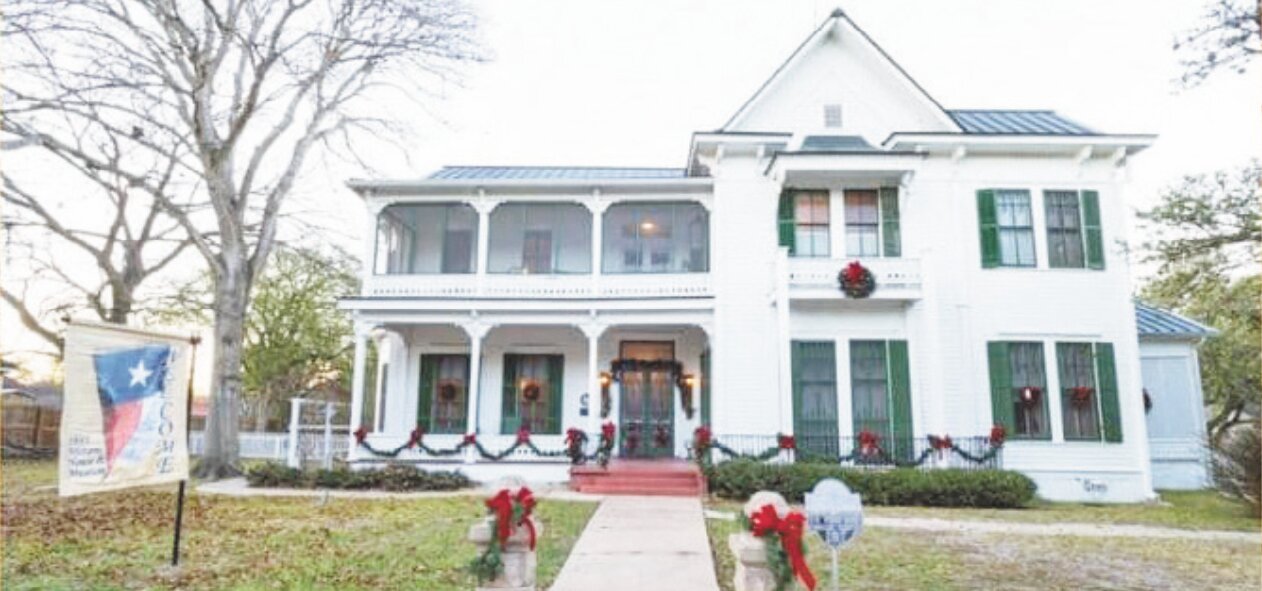Gonzales Historic Homes Winterfest Tour returns Dec. 2-3
The Gonzales Historic Homes Winterfest Tour returns Dec. 2-3 during the Winterfest weekend in Gonzales.
Experience the beauty of these historic homes, delightfully decorated for Christmas. As an added bonus, see the newly renovated chapel of the Episcopal Church of the Messiah. Your $25 ticket/wristband is valid for either day, from 2 p.m. to 6 p.m. Saturday, Dec. 2, or Sunday Dec. 3. Come and tour it!
Tickets may be purchased online at https://www.gonzaleshistorichomes.org or at Laurel Ridge Antiques, 827 St Joseph St, Gonzales, or the Gonzales Chamber of Commerce & Agriculture, 304 St Louis St, Gonzales.
Dilworth House
Robert Scott Dilworth was born September 24, 1868 in Gonzales, Texas. R.S., or Scott as he was called, was educated at the University of Virginia, returned home and went into the banking business with his father. Scott was a very astute businessman and in 1900 he joined C.J. Rather, Madden Fly and T.F. Harwood to build the Gonzales Cotton Mill, which prospered until the 190s. When his father died in 1911, Scott and his brother, Coke E. Dilworth, owned and operated the Dilworth Bank. In 1906 Scott and his wife employed noted architect J.Riely Gordon to design their Greek Revival house. Construction began about 1908 and was completed in 1911.
Episcopal Church of the Messiah
Following early missionary efforts in the Gonzales area, the Episcopal Church of the Messiah was established in 1855. Land at this site was granted by city officials, and construction of the Gothic Revival Sanctuary was completed in 1881. The vas replaced by the native stone bell tower in 1928. Interior furnishings include walnut woodwork produced from trees in the Guadalupe River area.
The Fauth Cottage
John Fauth, born April 7, 1833, in Derrenbach, Bavaria, Germany, immigrated to the United States through New York in 1852, settled in Buffalo and worked for two years learning the carriage and buggy trade. He came to Gonzales in 1858 and John opened his business. Although the Texas Historical Marker indicates that the house was built around 1857 by John Fauth, this is unlikely since Fauth did not purchase the property until 1868 and paid only $300 for the two lots. A review of the tax value records indicates that this Gothic Revival style cottage was probably completed in 1869 with modifications in 1884.
W.F. Robertson House
Step into the heartwarming elegance of the W.F. Robertson House. Completed in 1913, this beauty designed and built by Fred Meisenhelder, boasts period-true additions and embellishments that bring a sentimental familiarity to a span of generations. Surrounded by lush landscaping and the curious “three in the middle of the street,” the outdoor gardens make for a peaceful and serene retreat. Originally built as a three-bedroom and two-bath home, recent additions have evolved the home into a five-bedroom, three-and-a-half bath home with two additional flex spaces that can be used for offices or additional sleeping quarters. Prior to the turn of the century, a separate apartment and garage was added along with an RV pad. The Robertson family rests behind the home in the Masonic Cemetery, along with the Payson family that owned the home from the 1940s to 1970s.
TR Skinner House
The TR Skinner home is an example of a Queen Anne cottage. It was built circa 1914. The land was originally part of the neighboring Smead homestead. It has been a single family home, a duplex, a daycare and twenty years ago it was heading to the demolition list. Lovingly restored, the home featured abundant beadboard and original longleaf pine floors.
J.B. Wells House
This wonderfully preserved house was built by cattleman Thomas Newton Matthews. Thomas was born in Gonzales County April 4, 1849. By 1867, when he was only 18 years old, Thomas was in the cattle business and was extremely successful. In 1886, he moved to Coleman, Texas, where he continued his cattle business. He later moved to South Dakota.
This house is constructed of Florida longleaf pine shipped in by water to the old port of Indianola, Texas, and hauled to Gonzales by ox teams. It was quite modern for Its time, with fire escapes, lightning rods, and indoor plumbing. The house was purchased by James saucy Wells and on January 1,1890, Mr. and Mrs. Wells, their sixteen year old son, Charles, and their twelve year old daughter, Effie, moved to Gonzales from Leesville. Mr. Wells marked the date of the move on the old calendar clock on the mantel. Only the kitchen and bathrooms have been modernized and the total structure stands as it was built. This historic home now belongs to the Daughters of the Republic of Texas.
Comments







